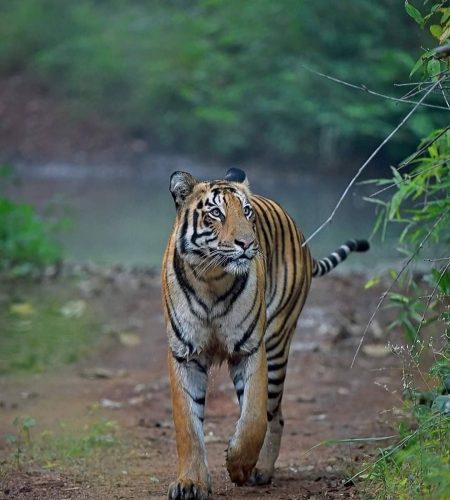Tadoba Tiger Reserve

Welcome To Tadoba National Park
Tadoba Andheri Tiger Reserve is a Tiger reserves in Chandrapur district of Maharashtra state in central India. It is notable as Maharashtra’s oldest and largest National Park. It is one of India’s 41 “Project Tiger” – Tiger reserves.
Etymology
The name ‘Tadoba’ is the name of the God “Tadoba” or “Taru”, praised by the tribal people who live in the dense forests of the Tadoba and Andhari region, while the Andhari River that meanders through the forest. gives the ‘Andhari’ name.
History
dedicated to the God Taru now exists beneath a huge tree, on the banks of the Tadoba Lake. The temple is frequented by adivasis, especially during the fair held every year in the Hindu month of Pausha, between December and January.
The Gond kings once ruled these forests in the vicinity of the Chimur hills. Hunting was completely banned in 1935. Two decades later, in 1955, 116.54 km2 (45.00 sq mi) was declared a National Park. Andhari Wildlife Sanctuary was created on the adjacent forests in 1986, and in 1995, both the park and the sanctuary were merged to establish the present Tiger Reserve
Topography
Tadoba Andheri Reserve is the largest national park in Maharashtra. Total area of the Reserve is 625.4 square kilometres (241.5 sq mi). This includes Tadoba National Park, created in 1955 with an area of 116.55 square kilometres (45.00 sq mi) and Andhari Wildlife Sanctuary created in 1986 with an area of 508.85 square kilometres (196.47 sq mi). The Reserve also includes 32.51 square kilometres (12.55 sq mi) Protected Forestand 14.93 square kilometres (5.76 sq mi) ‘Other areas’.
Densely forested hills form the northern and western boundary of the Tiger Reserve. The elevation of the hills ranges from 200 m (660 ft) to350 m (1,150 ft). To the southwest is the 120 ha (300 acres) Tadoba lake which acts as a buffer between the park’s forest and the extensive farmland which extends up to Irai water reservoir.This lake is a perennial water source which offers good habitat for Muggar crocodiles to thrive.Other wetland areas within the reserve include the Kolsa lake and Andhari river.
Tadoba reserve covers the Chimur Hills, and the Andhari sanctuary covers Moharli and Kolsa ranges. It’s bounded on the northern and the western side by densely forested hills. Thick forests are relieved by smooth meadows and deep valleys as the terrain slopes from north to south. Cliffs, talus and caves provide refuge for several animals. The two forested rectangles are formed of Tadoba and Andhari range. The south part of the park is less hilly.
Flora
Tadoba reserve is a predominantly Southern tropical Dry Deciduous Forest with dense woodlands comprising about 87 per cent of the protected area. Teakis the prdominant tree species. Other deciduous trees include Ain (crocodile bark), Bija, Dhauda, Haldu, Salai, Semal and Tendu. beheda, hirda, karaya gum, mahua Madhuca (Crepe myrtle) and Lannea coramandelica (Wodier Tree) are other common species.
Axlewood Anogeissus latifolia is a fire-resistant species growing here. Palas or Flame of the Forest Butea monosperma adds vibrant colour to the forest. Black plum trees grow in the riparian habitat around the lake. At the waterhole at Panchadhara, huge arjun trees are seen.
Patches of grasses are found throughout the reserve. Bamboo thickets grow throughout the reserve. The climber Kach Kujali (velvet bean) found here is a medicinal plant used to treat Parkinson’s disease. The leaves of bheria are used as an insect repellant and bija is a medicinal gum. Beheda is also an important medicine found here.
Itiadoh Dam
Itiadoh dam is an earthfill and gravity dam on Garvi river near Arjuni in state of Maharashtra in India.The height of the dam above lowest foundation is 29.85 m (97.9 ft) while the length is 505 m (1,657 ft). The volume content is 911 km3 (219 cu mi) and gross storage capacity is 288,830.00 km3(69,294.00 cu mi).
Fauna
Aside from around 65 of the keystone species Bengal tiger, Tadoba Tiger Reserve is home to other mammals, including: Indian leopards, sloth bears, gaur, nilgai, dhole, striped hyena, small Indian Civet, jungle cats, sambar, spotted deer, barking deer, chital, and chausingha.
Tadoba lake sustains the Marsh Crocodile, which were once common all over Maharashtra. Reptiles here include the endangered Indian python and the common Indian monitor. Terrapins, Indian star tortoise, Indian Cobra and Russel’s viper also live in Tadoba.
The lake is an ornithologist’s paradise with a wide diversity of water birds, and raptors. 195 species of birds have been recorded, including threeendangered species. The Grey-headed fish eagle, the Crested Serpent Eagle, and the Changeable Hawk-Eagle are some of the raptors.
Other interesting species include the Orange-headed Thrush, Indian Pitta, Crested Treeswift, Stone Curlew, Crested Honey Buzzard, Paradise Flycatcher, Bronze-winged Jacana and Lesser Goldenbacked Woodpecker. Warblers and the black-naped blue flycatcher exist here and the call of thepeacock may often be heard. 74 species of butterflies have been recorded including the pansies, monarch, Mormons and swordtails. Insect species include the endangered danaid egg-fly and great eggfly. Dragonflies, stick insects, jewel beetles and the praying mantis are other insects located in the reserve.
The signature spider, giant wood spider and red wood spiders are often seen during the monsoon and soon after. Some hunting spiders like the wolf spiders, crab spiders and lynx spiders are also common.
Threats
There are 41,644 people living in and around the reserve in 59 villages but none is settled inside the core zone. There are 41,820 cattle kept in the reserve but none in the core zone. While cattlegrazing is not allowed in the core zone, regulated grazing in the buffer zone is allowed to cattle of the village inhabitants. However, cattle of peripheral villages sometimes sneak into the reserve and cause additional damage to the habitat.
Forest fires are a constant problem in the dry season, consistently burning between 2% and 16% of the park each year. Poaching of prey such as Sambar deer, spotted deer, hare, nilgai and wild boar is also a near-permanent problem, not fully controlled.
Human-wildlife conflict is common, with killing of domestic livestock by tigers and leopards as a frequent phenomenon in the areas neighboring villages. This has an adverse impact on the economic condition of the local people and results into antagonism towards the management. In many years there have been up to 3 people and 30-50 cattle heads killed by tigers or leopards.
Visitor information
The main attraction of the Tadoba National Park is its jungle safari trips. Open top Gypsy vehicles, buses with trained local guides are available for visitors. Accommodation is also available at various locations.
Places of Interests to visit near Tadoba.
Tadoba National Tiger reserve
Jain Mandir (Bhadrawati) 27 Km. from Chandrapur.
Gaurala Ganpati Mandir (Bhadrawati) 27 Km. from Chandrapur.
Bhadranag Mandir (Bhadrawati) 27 Km. from Chandrapur.
ANANDWAN ASHRAM for Leprosy Patient by Baba Amte (Warora) 47 Km. from Chandrapur.
Ghodazari Talav (Nagbhir) 107 Km. from Chandrapur.
Asola mendha Talav ( Saoli)
Gaay Mukkh ( Talodhi Balapur)
Old Mahadeo temple (Palebarsa-Saoli)
Tulja Bhawani Mandir (Hanuman Khidki, Chandrapur)
Numbers Speak!

An Ideal package includes One safari drives in to the park, One cycles of meals (BLD). Basic Package is for six persons, sharing the room in double occupancy and using single jeep for safaris.It doesn’t mean that we do not cater to single / couple travelers.Yes of course we do, you may please discuss with us, our specialist will help in designing a bespoke itinerary for you. Please enquire for detailed itinerary.

Tadoba Package
1 Night / 2 Day Package Ex Nagpur
Package Cost
₹ 7,000/- per person
Included
- 1 Night accommodation on twin sharing basis
- One Breakfast, Lunch & Dinner
- 1 Jungle drive
- Ex. Nagpur Ac Vehicle transfer
- All Taxes
